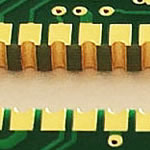Matlab 7.0.4a multi-paradigm numerical computing environment
China PCB Manufacturing, Shenzhen PCB Manufacturer, Making Circuit boards
PCB Contract manufacturer, PCB Fabrication, Turnkey assembly services
Buy Print circuit board, customer: /USA/UK/Canada/South Africa...
PCB Supplier Shenzhen, China, PCB Manufacturer, Turnkey services
-
PCBSINO is the Top 5 PCB manufacturer company in China.
PCBSINO do rapid Prototype within 24 hours. we can make Flexible Print circuit boards and Rigid circuit boards, like FR4, High TG FR4, Rogers 4003, 4350,Al Aluminum metal Core MCPCB, Al2O3 Ceramic,Taconic,Halogen Free material, CEM-3, Fr2, CEM-1, CEM-2, 94VO, Rogers HF material, Polymide,Flexible PCB FPC etc.
we already made many type electronic product for our customer, Our turkey services team can source original components part for your project, senior Electronic engineer will follow each step of the production and do function test in PCB house.
Express PCB |
|
Rigid PCB Rapid Prototype,24 hours |
| Fr4 PCB |
|
prototype Lower to 15USD ! |
| Rapid Prototype |
|
Fr4 Rigid PCB Rapid Prototype China, |
Turnkey Services |
|
Turnkey PCB Assembly Services, |
| Turnkey services |
|
Print circuit board Manufacturing, Turnkey Services |
| Turnkey Assembly |
|
Through Hole PCB components wave soldering Assembly |
Matlab 7.0.4a multi-paradigm numerical computing environment
-
Matlab 7.0.4a multi-paradigm numerical computing environment
MATLAB Newsgroup
MATLAB Central
Home
Post A New Message
Advanced Search
Visual Studio 2008 PE with Matlab 7.0.4
Subject: Visual Studio 2008 PE with Matlab 7.0.4
From: Gwendolyn Fischer
Date: 23 Jul, 2010 13:51:04
Message: 1 of 1
Reply to this message
Add author to My Watch List
View original format
Flag as spam
MATLAB 7.0.4 (R14SP2) officially supported on Mac OS X 10.4 (Tiger)
Subject: MATLAB 7.0.4 (R14SP2) officially supported on Mac OS X 10.4 (Tiger)
From: Steven Lord
Date: 5 May, 2005 17:21:06
Message: 1 of 3
Reply to this message
Add author to My Watch List
View original format
Flag as spam
MATLAB
From Wikipedia, the free encyclopedia
For the region in Bangladesh, see Matlab (Bangladesh).
Not to be confused with MATHLAB.
MATLAB
Matlab Logo.png
L-shaped membrane logo[1]
MATLAB R2013a Win8 screenshot.png
MATLAB R2013a running on Windows 8
Developer(s) MathWorks
Initial release 1984; 33 years ago
Stable release
R2017a / 9 March 2017; 5 months ago
Preview release None [±]
Development status Active
Written in C, C++, Java
Operating system Windows, macOS, and Linux[2]
Platform IA-32, x86-64
Type Numerical computing
License Proprietary commercial software
Website mathworks.com/products/matlab
MATLAB
Paradigm multi-paradigm: functional, imperative, procedural, object-oriented, array
Designed by Cleve Moler
Developer MathWorks
First appeared late 1970s
Stable release
9.1 (R2016b) / September 2016; 11 months ago
Preview release None [±]
Typing discipline dynamic, weak
Filename extensions .m
Website mathworks.com/products/matlab
Influenced by
APL EISPACK LINPACK PL/0 Speakeasy[3]
Influenced
Julia[4] Octave[5] Scilab[6]
MATLAB Programming at Wikibooks
Si8000 PCB Controlled Impedance Field Solver, MATLAB allows matrix manipulations, plotting of functions and data, implementation of algorithms, creation of user interfaces, and interfacing with programs written in other languages, including C, C++, C#, Java, Fortran and Python.
Although MATLAB is intended primarily for numerical computing, an optional toolbox uses the MuPAD symbolic engine, allowing access to symbolic computing abilities. An additional package, Simulink, adds graphical multi-domain simulation and model-based design for dynamic and embedded systems.
As of 2017, MATLAB has over 2 million users across industry and academia.[7] MATLAB users come from various backgrounds of engineering, science, and economics.
Contents [hide]
1 History
2 Syntax
2.1 Variables
2.2 Vectors and matrices
2.3 Structures
2.4 Functions
2.5 Function handles
2.6 Classes and object-oriented programming
3 Graphics and graphical user interface programming
4 Interfacing with other languages
5 License
6 Alternatives
7 Release history
8 File extensions
8.1 MATLAB
8.2 Simulink
8.3 Simscape
8.4 MuPAD
8.5 Third-party
9 Easter eggs
10 See also
11 Notes
12 References
13 External links
History[edit]
Cleve Moler, the chairman of the computer science department at the University of New Mexico, started developing MATLAB in the late 1970s.[8] He designed it to give his students access to LINPACK and EISPACK without them having to learn Fortran. It soon spread to other universities and found a strong audience within the applied mathematics community. Jack Little, an engineer, was exposed to it during a visit Moler made to Stanford University in 1983. Recognizing its commercial potential, he joined with Moler and Steve Bangert. They rewrote MATLAB in C and founded MathWorks in 1984 to continue its development. These rewritten libraries were known as JACKPAC.[9] In 2000, MATLAB was rewritten to use a newer set of libraries for matrix manipulation, LAPACK.[10]
MATLAB was first adopted by researchers and practitioners in control engineering, Little's specialty, but quickly spread to many other domains. It is now also used in education, in particular the teaching of linear algebra, numerical analysis, and is popular amongst scientists involved in image processing.[8]
We have qualified and now support MATLAB 7.0.4 (R14SP2) on Mac OS X 10.4
(Tiger). For more information about the platforms on which MATLAB is
supported, please see:
New features and enhancements introduced in this release.
Platform Limitations
Platform-related limitations to the MATLAB functionality described in these Release Notes and in the MATLAB documentation.
Upgrading from an Earlier Release
Changes in MATLAB, made since MATLAB 7.0.1, that may require changes to existing applications.
Major Bug Fixes
Particularly important bug fixes made since MATLAB 7.0.1.
If you are viewing these Release Notes in PDF form, please refer to the HTML form of the Release Notes, using either the Help browser or the MathWorks Web site and use the link provided.
Known Software and Documentation Problems
Significant problems that still exist in the MATLAB code or documentation.
If you are viewing these Release Notes in PDF form, please refer to the HTML form of the Release Notes, using either the Help browser or the MathWorks Web site and use the link provided.
Printable Release Notes
PDF version of these Release Notes.
This page documents incompatibilities accross MATLAB versions. For each MATLAB release, it gives the main changes appearing in that release and that Dynare needs to handle.
Note that all changes are not documented, please refer to the official release notes for a full list: for releases up to 6.5.1 (R13SP1), and for releases since 7.0 (R14).
Dynare deals with these incompatibilities at three places:
in the configure script, via the various m4 macros for MATLAB
in the M-files, mainly through matlab/dynare_config.m
in the C++ source for MEX files, mainly through dynmex.h, dynblas.h and dynlapack.h in mex/sources
MATLAB 8.3 (R2014a)
MATLAB 8.2 (R2013b)
MATLAB 8.1 (R2013a)
MATLAB 8.0 (R2012b)
MATLAB 7.14 (R2012a)
MATLAB 7.13 (R2011b)
MATLAB 7.12 (R2011a)
MATLAB 7.11 (R2010b)
MATLAB 7.10 (R2010a)
MATLAB 7.9 (R2009b)
MATLAB 7.8 (R2009a)
MATLAB 7.7 (R2008b)
MATLAB 7.6 (R2008a)
MATLAB 7.5 (R2007b)
MATLAB 7.4 (R2007a)
MATLAB 7.3 (R2006b)
MATLAB 7.2 (R2006a)
MATLAB 7.1 (R14SP3)
MATLAB 7.0.4 (R14SP2)
MATLAB 7.0.1 (R14SP1)
MATLAB 7.0 (R14)
MATLAB 8.3 (R2014a)
mex internals have changed
the name of some variables for optimization/linking flags has changed
the quoting rules for variable redefinition have changed
flipdim now obsolete (replace by flip)
New functions isdiag, isbanded, issymmetric, ishermitian, istril, istriu, and bandwidth for testing matrix structure
New function sylvester for solving the Sylvester equation
New option for eig function for computing left eigenvectors
New option for rand, randi, and randn functions for creating arrays of random numbers that match data type of an existing variable
Some improvements to readtable
MATLAB 8.2 (R2013b)
Many changes in repmat calling syntax. Some issue warnings, some issue errors
MATLAB 8.1 (R2013a)
Under GNU/Linux, option -nojvm is now incompatible with the usage of graphic handles
New functions: strsplit, strjoin, flintmax,
Error and warnings identifiers have changes (how they changed is not documented in the release notes…)
The behavior of unique, union, intersect, setdiff, setxor, and ismember has changed
Removed functions: cholinc, luinc, setDefaultStream and getDefaultStream of RandStream class
MATLAB 8.0 (R2012b)
Syntax for abstract classes
switch constructs can behave differently when given enumerations
Classes can define a property attribute only once in a properties block
New functions: ddensd, atan2d
Interface changes for: besselh, besseli, besselj, besselk, bessely, airy, psi
Removed functions: wklinfo, wklread, wklwrite
Bit-wise operations now support signed integers
xlsread now reads data from XLSM, XLTX, and XLTM files and supports named ranges on all platforms
Multiple delimiter support in textscan function
MATLAB 7.14 (R2012a)
New functions: integral, integral2, and integral3
Removed functions: griddata3, delaunay3, tsearch, dsearch
MATLAB 7.13 (R2011b)
New class griddedInterpolant for interpolation
New options for randperm, RandStream.randperm, qr
Behavior changed for meshgrid and ndgrid
Removed function: bessel
New functions: matfile, narginchk (replaces nargchk)
Behavior changed for nargoutchk
Some error and warning identifiers have changed
MATLAB 7.12 (R2011a)
New functions: rng, ichol
New options for gammainc
qr behaviour is reverted back to pre-R2010a behaviour (see R2010a releases notes)
Deprecated functions: luinc, cholinc
The old methods for random generators (rand or randn with 'seed', 'state' or 'twister' inputs) are deprecated in favor of rng
The getDefaultStream and setDefaultStream methods of RandStream class are deprecated in favor of getGlobalStream and setGlobalStream methods
New higher-level functions for HDF5 format, replacing older interface
Regular expressions in MATLAB now support successful zero-length matching
MATLAB 7.11 (R2010b)
New functions: isrow, iscolumn, and ismatrix
Deprecated functions: bessel, erfcore, intwarning, mmreader, wavplay, wavrecord, wk1finfo, wk1read, wk1write
Core MATLAB functions do 64-bit integer arithmetic (int64 and uint64 classes)
Change in the behavior of timeseries objects
The arrayfun function now accepts an array of objects as an input. The output can also be a scalar object, as long as the UniformOutput flag is set to false.
In previous versions of MATLAB, calling isequalwithequalnans to compare identical arrays of objects that contain one or more NaN (Not a Number) values incorrectly returned false. Similarly, calling isequal to compare identical arrays of objects that contain NaNs incorrectly returned true. In MATLAB version 7.11, these functions return the expected values (true for isequalwithequalnans, and false for isequal) when used to compare object arrays.
4th return argument of fileparts removed
Options -inline and -argcheck of mex command removed
MATLAB 7.10 (R2010a)
the following functions are now deprecated (but still work): isstr, setstr, str2mat, strread, strvcat, textread. See http://www.mathworks.com/access/helpdesk/help/techdoc/rn/br_bpq8-1.html#bsdnyvb-1 for their replacements
in the output of the qr function, R now contains only real, nonnegative diagonal elements. Since the QR factorization is not unique, the answer is still correct. In previous releases, the diagonal of R could contain complex and negative elements.
if you have a function, such as the following, that returns a struct array:
I had to change my compiler from Visual Studio 6.0 to MVS 2008 (9.0). As I'm using Matlab 7.0.4 this is not a supported compiler.
So when I tried to mex a file I get an error message:
"Could not find the compiler "cl" on the DOS path.
Use mex -setup to configure your environment properly.
C:\PROGRAM FILES\MATLAB704\BIN\WIN32\MEX.PL: Error: Unable to locate compiler. "
I already tried to install
http://www.mathworks.com/matlabcentral/fileexchange/18508-microsoft-visual-studio-2008-mex-and-mbuild-setup-files
But still no success.
Has anybody succeeded in usin MVS2008 with Matlab 7.0.4?
For furhter information, please feel free to contact us, www.pcbsino.com

